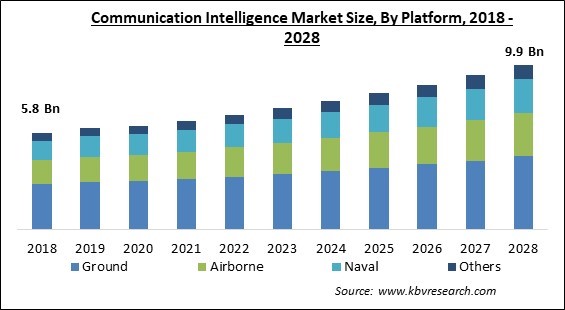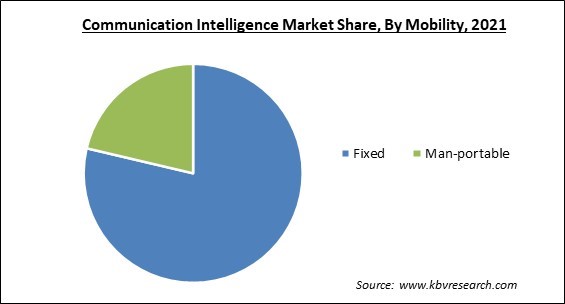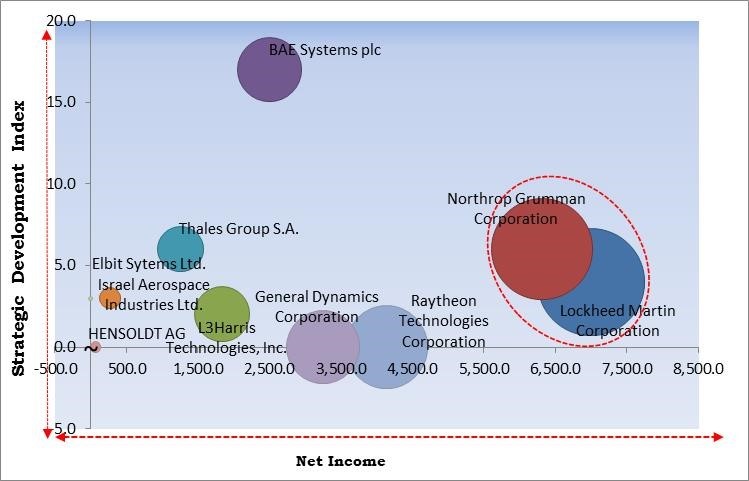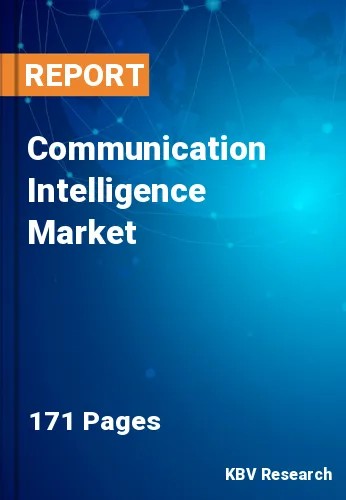The Global Communication Intelligence Market size is expected to reach $9.9 billion by 2028, rising at a market growth of 6.2% CAGR during the forecast period.
Wireless communication technology, called the communication Intelligence or COMINT system, is used on battlefields to locate radios, monitor the radio, and intercept hostile radar signals. COMINT transmits data from one point to another via electromagnetic signals. For example, military radio traffic, electromagnetic signals, and fax transmissions are all decoded using COMINT, transforming the information into usable forms like images, sounds, or data that can be quickly studied.

Modern networking and satellite communications systems are supported, which are extensively employed by defense forces worldwide. It can be used from any level, including aerial, ground, and naval. Additionally, information that helps a person or organization make decisions that give them a strategic edge is called intelligence.
Communications between people, or COMINT, exposes the transmitter, the transmitter's location if the transmitter is moving, and the transmitter's organizational role if known. It also provides the transmission's start time, end time, and schedule (if it's a periodic transmission), along with its frequency and other technical details. Details about the transmission also include encryption and whether it can be unlocked.
The language of the transmission and a translation, whether it is possible to intercept initially transmitted clear text or retrieve it by cryptanalysis, can also be known through the COMINT. COMINT further analyses if addresses can be retrieved from the message, particularly if the signal is not from a general broadcast. This is because sending stations could also be COMINT (such as a message confirmation or a response), ELINT (such as a navigation beacon activating), or both. In addition, information on the responder's position and signal characteristics may be included instead of, or in conjunction with, an address or another form of identification.
A robust communication network was required for the internal operations of various governments and their efforts to provide humanitarian and medical relief. In addition, how nations create and protect their national security strategies was impacted by international conflicts, the rapid emergence of terrorism, and the COVID-19 pandemic. Since funds for defense programs were set aside before the outbreak by many nations, the need for military equipment was secured to a greater extent. As a result, the demand for COMINT systems is expected to grow in the coming years. Additionally, the higher spending on military by governments worldwide is also expected to have positive long-term effects on the market.
The security and secrecy of military communications are the main requirements of the defense sector. Due to the increasing volume of IP-based data, comprising remote sensor data and situational awareness video exchanged through industry-standard interfaces, advanced data connection security is necessary. Additionally, given that digital resources, whether on the ground, in space, or the air, are vulnerable to a range of threats, safeguarding military satellites against cyberattacks has become increasingly crucial. Security flaws in military network infrastructure and communication data could endanger public safety, given their significance. To stop this, the defense sector is deploying secure military communications systems. Therefore, these elements are expected to enhance the growth of the communication intelligence market.
COMINT is essential for information gathering, wireless signal analysis, reverse engineering, and information gathering. Communication intelligence is extremely crucial to government and military agencies. Additionally, the aerospace and military industries are gracefully embracing technological advancements like Industry 4.0, the Internet of Things, AI, ML, and other technologies that significantly digitize the defense industry's operations. These concurrently increase the risk of cyberattacks as well. Hence, the rising use of communication intelligence in cyber and electronic warfare is beneficial for expanding the market.
Military organizations find implementing cutting-edge and innovative technology and products challenging due to budgetary restrictions and a lack of competent staff. Money constraints frequently prevent the introduction of advanced communication systems. Reduced defense spending has been stated by nations who are emerging from economic difficulties. Countries worldwide are researching and inviting creative military system options to reduce costs. As a result, the COMINT technology is shifting from the defense to the commercial sectors.
Based on mobility, the communication intelligence market is categorized into fixed and man portable. The fixed segment garnered the highest revenue share in the communication intelligence market in 2021. Due to the ability to shift weapon systems or combat forces from point A to point B by intercepting the enemy's communication networks, mobility is acknowledged as a crucial element of the modern battlefield. Additionally, fixed systems may be advantageous when dealing with large, heavy, and powerful systems and equipment.
On the basis of platform, the communication intelligence market is divided into airborne, ground, naval, and others. The naval segment recorded a significant revenue share in the communication intelligence market in 2021. COMINT technologies aid naval forces in their operations as well. They scan and gather intercepted foreign communications and non-communications using cutting-edge technologies. They recognize and process intercepted communications before analyzing them to discover targets and operating patterns.

| Report Attribute | Details |
|---|---|
| Market size value in 2021 | USD 6.6 Billion |
| Market size forecast in 2028 | USD 9.9 Billion |
| Base Year | 2021 |
| Historical Period | 2018 to 2020 |
| Forecast Period | 2022 to 2028 |
| Revenue Growth Rate | CAGR of 6.2% from 2022 to 2028 |
| Number of Pages | 171 |
| Number of Tables | 263 |
| Report coverage | Market Trends, Revenue Estimation and Forecast, Segmentation Analysis, Regional and Country Breakdown, Competitive Landscape, Companies Strategic Developments, Company Profiling |
| Segments covered | Mobility, Platform, Region |
| Country scope | US, Canada, Mexico, Germany, UK, France, Russia, Spain, Italy, China, Japan, India, South Korea, Singapore, Malaysia, Brazil, Argentina, UAE, Saudi Arabia, South Africa, Nigeria |
| Growth Drivers |
|
| Restraints |
|
Based on region, the communication intelligence market is analyzed across North America, Europe, Asia Pacific, and LAMEA. The North America segment procured the highest revenue share in the communication intelligence market in 2021. Since the US has continuously been a leader in implementing new technology for the country's defense sector, the demand for COMINT in North America is high. COMINT will eventually gain from higher funding as the most complex use of science & technology for intelligence and military objectives. The ongoing development and application of technology have been a defining feature of the military worldwide.
Free Valuable Insights: Global Communication Intelligence Market size to reach USD 9.9 Billion by 2028

The major strategies followed by the market participants are Partnership. Based on the Analysis presented in the Cardinal matrix; Lockheed Martin Corporation and Northrop Grumman Corporation are the forerunners in the Communication Intelligence Market. Companies such as BAE Systems plc, Thales Group S.A. and Raytheon Technologies Corporation are some of the key innovators in Communication Intelligence Market.
The market research report covers the analysis of key stake holders of the market. Key companies profiled in the report include BAE Systems PLC, L3Harris Technologies, Inc., Thales Group S.A., Northrop Grumman Corporation, Lockheed Martin Corporation, Elbit Sytems Ltd., Raytheon Technologies Corporation, General Dynamics Corporation, HENSOLDT AG, and Israel Aerospace Industries Ltd.
By Mobility
By Platform
By Geography
The global Communication Intelligence Market size is expected to reach $9.9 billion by 2028.
Rising need for securing military and defense communications are driving the market in coming years, however, High costs associated with the implementation of the COMINT system restraints the growth of the market.
BAE Systems PLC, L3Harris Technologies, Inc., Thales Group S.A., Northrop Grumman Corporation, Lockheed Martin Corporation, Elbit Sytems Ltd., Raytheon Technologies Corporation, General Dynamics Corporation, HENSOLDT AG, and Israel Aerospace Industries Ltd.
The Ground segment acquired maximum revenue share in the Global Communication Intelligence Market by Platform in 2021 thereby, achieving a market value of $4.4 billion by 2028.
The North America market dominated the Global Communication Intelligence Market by Region in 2021, and would continue to be a dominant market till 2028; thereby, achieving a market value of $3.9 billion by 2028.
Our team of dedicated experts can provide you with attractive expansion opportunities for your business.

